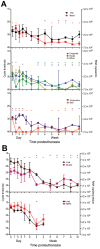Postmortem stability of Ebola virus
- PMID: 25897646
- PMCID: PMC4412251
- DOI: 10.3201/eid2105.150041
Postmortem stability of Ebola virus
Abstract
The ongoing Ebola virus outbreak in West Africa has highlighted questions regarding stability of the virus and detection of RNA from corpses. We used Ebola virus-infected macaques to model humans who died of Ebola virus disease. Viable virus was isolated <7 days posteuthanasia; viral RNA was detectable for 10 weeks.
Keywords: Ebola hemorrhagic fever; Ebola virus; Ebola virus disease; West Africa; cynomolgus macaques; outbreak; postmortem stability; transmission; viruses.
Figures


References
-
- Centers for Disease Control and Prevention. Ebola hemorrhagic fever [cited 2015 Jan 3]. http://www.cdc.gov.ezproxy.nihlibrary.nih.gov/vhf/ebola/
-
- Ng S, Cowling B. Association between temperature, humidity and ebolavirus disease outbreaks in Africa, 1976 to 2014. Euro Surveill. 2014;19:20892 . - PubMed
Publication types
MeSH terms
Substances
Grants and funding
LinkOut - more resources
Full Text Sources
Other Literature Sources
Medical

